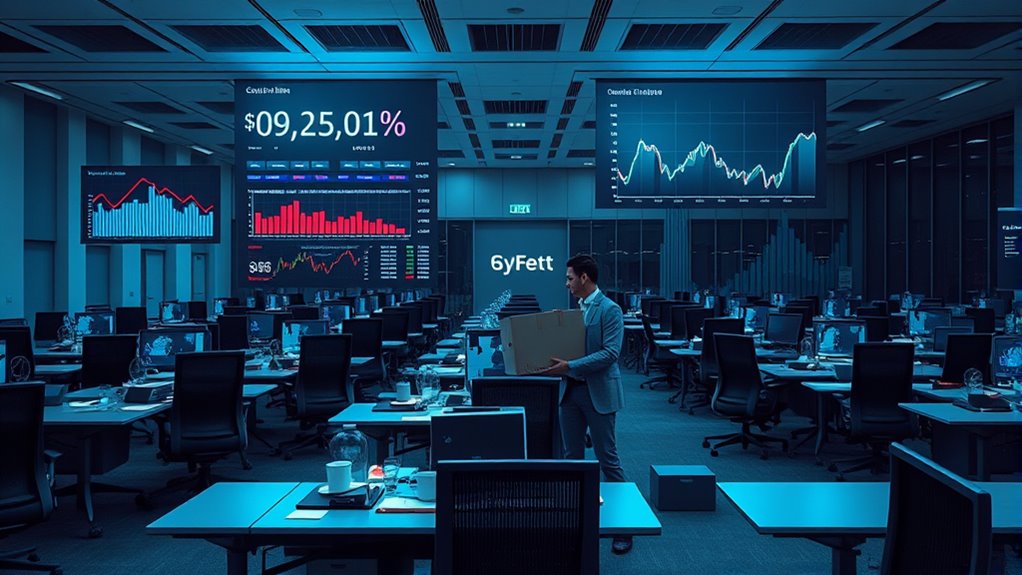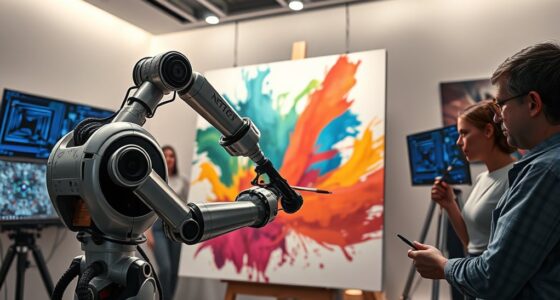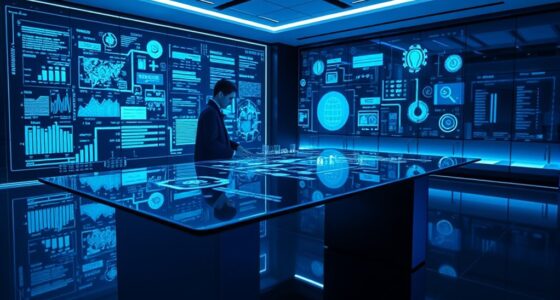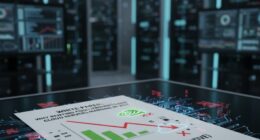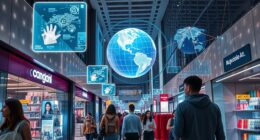In 2025, AI-driven automation led to massive layoffs in the tech industry, with nearly 78,000 jobs cut across hundreds of companies. Roles in software engineering, HR, and entry-level positions are especially vulnerable as AI takes over repetitive tasks. Companies focus more on AI investments, risking long-term innovation. Understanding these lessons can help you grasp how automation shapes job security and industry shifts—if you look deeper, you’ll uncover even more insights.
Key Takeaways
- Major layoffs in 2025 impacted over 78,000 jobs across 342 tech firms, with AI-driven automation replacing many roles.
- Companies like Microsoft and IBM cut thousands of jobs, particularly in software engineering and HR, due to AI efficiencies.
- AI automation now handles coding, customer service, and HR tasks, reducing reliance on human workers.
- Workforce reductions highlight risks to innovation, creativity, and entry-level employment amid rapid AI adoption.
- Limited government regulation increases industry reliance on AI, emphasizing the need to balance efficiency gains with human workforce protections.

AI Layoffs Tracker
Are AI-driven layoffs reshaping the tech industry faster than anyone expected? The numbers tell a compelling story. In 2025, nearly 78,000 jobs have been cut across 342 tech companies, with over 64,000 layoffs reported by mid-year. February alone saw more than 16,200 layoffs, and April added another 24,500 to the tally. May’s layoffs exceeded 10,300, highlighting a rapid, ongoing trend. These cuts aren’t isolated; they reflect a broader shift towards efficiency and automation, as seen in companies like Rec Room, which announced a 16% workforce reduction to streamline operations.
AI-driven layoffs in 2025 are accelerating industry shifts, with thousands of jobs cut across tech giants amid automation trends.
Major players like Microsoft have led the wave, laying off around 6,000 employees in May and planning another 9,000 layoffs later that year. Software engineers constitute a significant portion of these layoffs, with about 40% of Microsoft’s cuts affecting them. IBM has also announced large-scale redundancies, including 8,000 recent layoffs followed by a planned 9,000 in HR roles. Meta has reduced its workforce by roughly 5%, targeting low performers to optimize productivity. Amazon, meanwhile, cut approximately 100 roles in its Devices division, and Google laid off hundreds as it shifted its focus to AI investments. These trends are further amplified by the increasing adoption of automation across various sectors.
The impact on workforce structure is profound. Software engineering and white-collar roles face increasing risk, particularly as companies automate tasks traditionally handled by humans. HR departments are not immune; IBM’s example shows automation replacing many HR functions. Entry-level positions are also under threat, with industry leaders warning that AI may diminish opportunities for new entrants. Meanwhile, companies are reallocating budgets toward AI development and deployment, emphasizing automation’s strategic importance. According to Trueup.io, 76,440 jobs have already been lost to AI automation this year, underscoring the immediacy of the crisis.
AI-driven initiatives accelerate this trend. AI systems now handle repetitive tasks in coding, customer service, and HR processes. Microsoft employs AI to write roughly 20-30% of its code, boosting efficiency but reducing the need for human coders. OpenAI’s CEO notes that AI enables single-person startups to challenge larger firms, further disrupting traditional job markets. According to the World Economic Forum, 41% of employers are planning workforce reductions, citing automation as a primary driver. These initiatives aim to cut costs and increase output but raise ethical questions about the future of human employment.
Despite the data, government responses remain limited in scope. Policy debates around regulation, worker protections, and corporate responsibility are ongoing but not yet conclusive. Experts warn that short-term cuts risk harming future innovation and losing human creativity essential for breakthrough ideas. As layoffs continue, industry leaders and workers alike grapple with the implications of AI’s expanding role, questioning whether efficiency gains justify the human cost. The trend signals a transformative period in tech, where the balance between automation and human ingenuity remains uncertain.
Frequently Asked Questions
What Industries Are Most Affected by AI Layoffs?
You’ll notice that tech, education, finance, and consulting are most affected by AI layoffs. In tech, giants like Microsoft, Meta, and Google cut thousands to fund AI growth. Education platforms replace tutors with chatbots. Finance firms automate accounting and risk management, while consulting companies cut staff to focus on AI-powered analytics. These industries see significant shifts, with roles in administrative tasks, content creation, and data analysis most impacted by automation.
How Do AI Layoffs Impact Overall Tech Employment Trends?
AI layoffs markedly reshape tech employment trends by reducing mid-level and routine roles, especially in programming and administrative areas. You’ll notice a shift toward specialized positions like prompt engineers and AI ethicists, but overall, job opportunities in traditional tech roles decline. As companies reallocate resources to AI infrastructure, you might find more growth in emerging fields or sectors like healthcare and finance, but stability in classic tech jobs decreases.
Are There Geographic Hotspots for AI Job Cuts?
You’ll notice that AI job cuts are concentrated in specific regions. The US, especially Silicon Valley and Seattle, experiences significant layoffs, mainly in tech giants. Europe’s industrial hubs like Germany and financial centers such as London and Frankfurt also face disruptions. These hotspots reflect where AI adoption accelerates fastest, impacting local employment. Keep an eye on regional trends, as they reveal how AI reshapes jobs differently across the globe.
What Are the Common Reasons Behind the AI Layoffs?
You notice that AI layoffs happen mainly because companies are reallocating funds to AI initiatives, aiming for long-term growth. They replace repetitive roles with AI tools, focus on AI-specific skills, and restructure teams for better adaptability. Economic pressures also push firms to cut costs quickly, balancing high R&D expenses with profitability. These layoffs reflect strategic shifts toward AI-driven markets, streamlining operations, and ensuring competitiveness in an evolving tech landscape.
How Can Impacted Workers Transition to New Roles?
You might worry about your skills becoming obsolete, but you can shift to new roles by pursuing AI certifications in high-demand areas like machine learning or ethics. Upskill through online programs, leverage company or government support, and target emerging fields like AI ethics or healthcare AI. Stay adaptable, join professional networks, and consider gig work while training. These steps can help you smoothly shift into a thriving AI-focused career.
Conclusion
As you reflect on 2025’s largest AI layoffs, remember they symbolize more than just job cuts—they represent a chrysalis of change. Like a phoenix emerging from ashes, the industry’s resilience and adaptability will forge new opportunities from these setbacks. Embrace this moment as a catalyst for growth, knowing that every ending signals a new beginning. In this cycle of renewal, the true essence of progress is born from the ashes of what once was.
